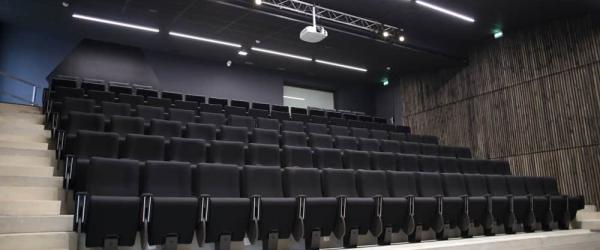Titre : "Spatial profiling of age-associated remodeling of the thymic microenvironment"
|
Date: Thursday, December 11 at 2:30 p.m. Location: CIML Auditorium. Composition of the jury Paola Bonfanti | Rapporteuse & Présidente du jury PR, The Francis Crick Institute, University College London
Marco A. Mendoza | Rapporteur CR, HDR, Genoscope, Université Paris-Saclay
Matthieu Giraud | Examinateur CR, HDR, CR2TI, Nantes Université
Denis Puthier | Directeur de thèse PR, TAGC, Aix-Marseille Université
Magali Irla | Co-encadrante DR, HDR, CIML, Aix-Marseille Université
Arnauld Sergé | Co-directeur de thèse & Membre invité MCU, HDR, LAI, Aix-Marseille Université
Salvatore Spicuglia | Membre invité DR, HDR, TAGC, Aix-Marseille Université
|
|
Le thymus est composé de deux régions spatialement distinctes : le cortex et la médulla, chacune comprenant des microenvironnements stromaux spécialisés qui coordonnent les différentes étapes du développement des lymphocytes T (LT). En particulier, les interactions bidirectionnels, appelées « crosstalk », entre les LT et les cellules épithéliales thymiques (CET) contrôlent non seulement le développement des LT, mais induisent également la différenciation et l'organisation des CET. Le séquençage d’ARN à l’échelle de la cellule unique (scRNA-seq) a révélé une hétérogénéité inattendue des cellules stromales épithéliales et non épithéliales. Avec l'âge, le thymus involue, entraînant une altération de son architecture, une réduction de la production de LT naïfs et une diminution de la diversité du répertoire des récepteurs des LT. Ce déclin contribue à une incidence accrue de cancers, d’infections et d'auto-immunité chez les personnes âgées. Bien que des défauts de prolifération et de différenciation des CET constituent des facteurs précoces de l'involution thymique, les mécanismes sous-jacents restent mal compris, notamment en raison de la compréhension limitée des changements liés à l’âge du microenvironnement stromal.
En combinant des techniques de scRNA-seq et de transcriptomique spatiale (TS), nous avons étudié la distribution spatiale de plus de 40 types cellulaires du thymus au cours de l’âge. Nous avons montré que le vieillissement modifie la composition, l'état transcriptionnel et l'organisation spatiale des CET. L’utilisation de deux approches de TS, l’une basées sur le séquençage de nouvelle génération et l’autre sur la détection simultanée de transcrits d’ARN, a révélé qu’à un âge intermédiaire la médulla est remodelée en zones résiduelles, encore fonctionnellement actives. Ces zones conservent des caractéristiques du microenvironnement thymique jeune, caractérisées par une grande diversité cellulaire, tant épithéliales que non épithéliales, ainsi qu’une expression de molécules de signalisation essentielles à l'intégrité du microenvironnement et à la production de LT matures. Nous avons observé un enrichissement en LT conventionnels CD4+ et CD8+ simples positifs, ainsi qu’en LT non conventionnels, notamment les cellules T régulateurs Foxp3+, les LT γδ et les cellules Natural Killer, dans les zones résiduelles, suggérant le maintien d’un crosstalk cellulaire actif. Collectivement, nos résultats permettent de cartographier, à haute résolution, le remodelage du thymus au cours de l’âge. L'identification de zones médullaires résiduelles et fonctionnellement actives devrait approfondir notre compréhension de l'involution thymique et ouvrir potentiellement la voie au développement de thérapies régénératives ciblant le thymus.
Mots clés : cellule T, stroma, microenvironnement, involution thymique, scRNA-seq, transcriptomique spatiale
The thymus is composed of spatially distinct cortical and medullary regions, each comprising specialized stromal microenvironments that support discrete stages of T cell development. In particular, thymic crosstalk, the bidirectional interactions between thymocytes and thymic epithelial cells (TECs), not only mediate T cell development but also drive TEC differentiation and organization. Single-cell RNA sequencing (scRNA-seq) has revealed unexpected heterogeneity among both epithelial and non-epithelial stromal subsets. Thymic function progressively declines with age, a process known as age-related thymic involution, leading to reduced naïve T cell output and diminished T cell receptor repertoire diversity. Impaired T cell-mediated immunity contributes to an increased incidence of cancer, infections, and autoimmunity in the elderly. Although defects in TEC proliferation and differentiation are early drivers of age-related thymic involution, the underlying mechanisms remain poorly understood, particularly due to our limited knowledge of how stromal microenvironments evolve with age.
In this work, we leveraged scRNA-seq and spatial transcriptomics (ST) to resolve the spatial distribution of over 40 cell types across the stromal and hematopoietic compartments of the aging thymus. We showed that aging reconfigures TEC composition, transcriptional state, and spatial organization. Notably, whole-transcriptome and imaging-based ST analysis uncovered that the medulla is remodeled into sparse, yet functionally active, zones by middle-age. These zones retain hallmarks of the young thymic microenvironment, including high cell type diversity across epithelial and non-epithelial stromal subsets, along with sustained expression of signaling molecules necessary for microenvironmental integrity and the generation of mature T cells. We found that conventional CD4+ and CD8+ single-positive T cells, as well as unconventional subsets, including Foxp3+ regulatory T cells, γδ T cells, and natural killer T cells are enriched in residual zones, suggesting sustained thymic crosstalk particularly within these areas. Collectively, our findings elucidate the architectural remodeling of the aging thymus at unprecedented resolution. The identification of residually active medullary zones is expected to deepen our understanding of age-related thymic involution, potentially paving the way for the development of thymic regenerative therapies.
Key words: T cell, stroma, microenvironment, age-related thymic involution, scRNA-seq, spatial transcriptomics

